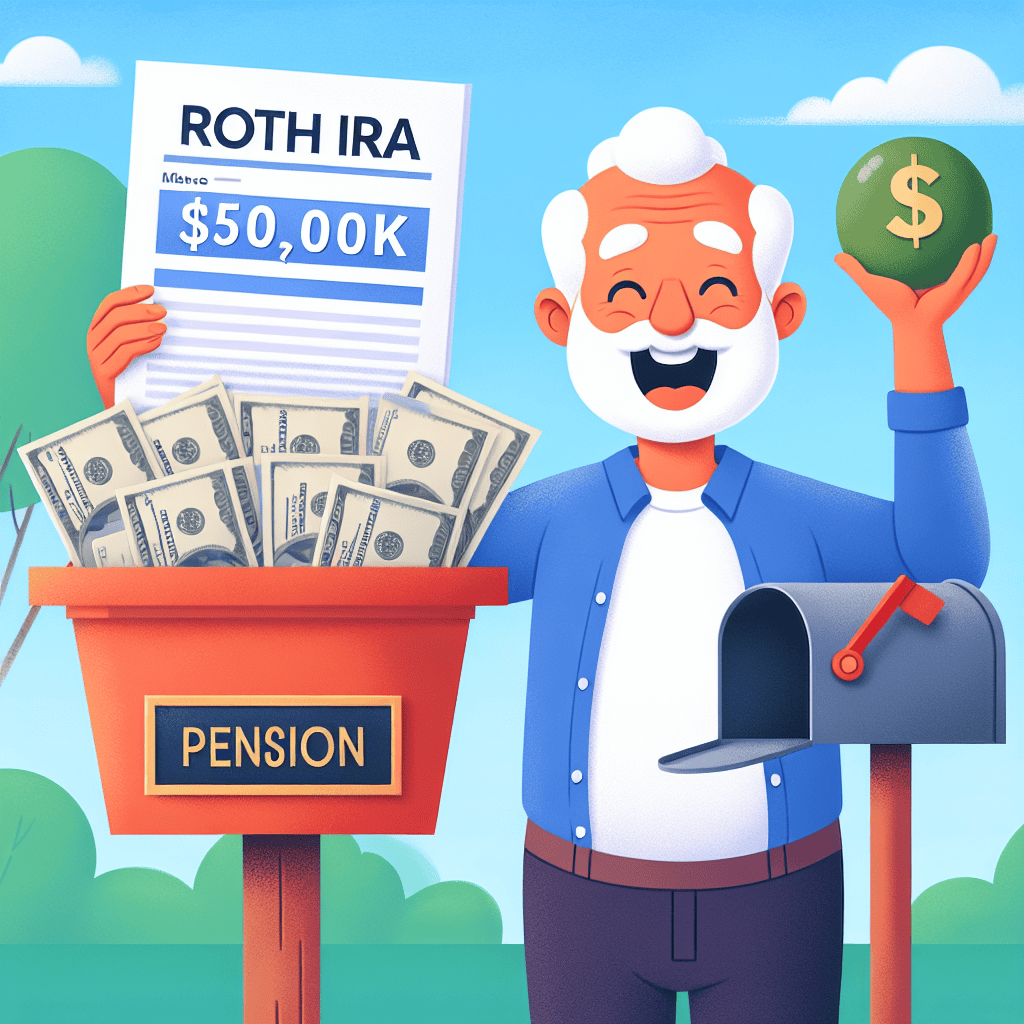“Retire Smart: Making $500k and $2,000 Monthly Work for Your Golden Years!”
Introduction
Retiring at the age of 62 with a financial portfolio consisting of $500,000 in a Roth IRA and a combined monthly income of $2,000 from Social Security and pension benefits presents a scenario that requires careful financial planning and consideration. The feasibility of this retirement plan hinges on several factors, including the individual’s lifestyle expectations, healthcare needs, inflation rates, and investment strategies. With the Roth IRA offering tax-free withdrawals, it provides a flexible source of income, while the steady monthly income from Social Security and pension can cover essential expenses. However, the success of this retirement plan will largely depend on the retiree’s ability to manage expenses, adjust to potential economic changes, and ensure that their savings last throughout their retirement years.
Evaluating Financial Security: Retiring at 62 with $500k in Roth
Retiring at the age of 62 is a dream for many, offering the promise of leisure and the opportunity to pursue personal interests. However, the feasibility of this dream largely depends on one’s financial preparedness. For individuals with $500,000 in a Roth IRA and a combined monthly income of $2,000 from Social Security and pension, evaluating financial security becomes crucial. This assessment involves understanding the sustainability of these resources over the course of retirement, which could span several decades.
To begin with, the $500,000 in a Roth IRA provides a significant financial cushion. The Roth IRA is particularly advantageous due to its tax-free growth and withdrawals, which can be strategically used to manage tax liabilities in retirement. However, the key question is whether this amount, combined with the monthly income, can sustain a comfortable lifestyle. Assuming a conservative withdrawal rate of 4% per year, the Roth IRA could provide an additional $20,000 annually. This, when added to the $24,000 from Social Security and pension, results in a total annual income of $44,000.
While this figure may seem adequate, it is essential to consider various factors that could impact financial security. Inflation, for instance, erodes purchasing power over time, necessitating a careful evaluation of future expenses. Healthcare costs, which tend to rise with age, are another critical consideration. Medicare eligibility begins at 65, leaving a potential gap in coverage for those retiring at 62. Bridging this gap may require purchasing private health insurance, which can be costly.
Moreover, lifestyle expectations play a significant role in determining the sufficiency of retirement funds. Individuals accustomed to a higher standard of living may find $44,000 annually insufficient, especially if they plan to travel extensively or pursue expensive hobbies. Conversely, those with modest needs and a debt-free lifestyle may find this income adequate. It is also important to account for unexpected expenses, such as home repairs or medical emergencies, which can strain financial resources.
In addition to these considerations, investment strategies can influence the longevity of retirement savings. A well-diversified portfolio that balances growth and risk is essential to ensure that the Roth IRA continues to generate returns. However, market volatility poses a risk, particularly in the early years of retirement, when significant losses can have a lasting impact. Therefore, it is advisable to periodically review and adjust investment strategies to align with changing financial needs and market conditions.
Furthermore, individuals should explore ways to supplement their income, such as part-time work or monetizing hobbies, which can provide additional financial security and personal fulfillment. Engaging in such activities not only boosts income but also helps maintain social connections and mental well-being.
In conclusion, retiring at 62 with $500,000 in a Roth IRA and $2,000 monthly from Social Security and pension is feasible for some, but it requires careful planning and consideration of various factors. By understanding the potential challenges and proactively managing resources, individuals can enhance their financial security and enjoy a fulfilling retirement. Ultimately, the key lies in aligning financial strategies with personal goals and circumstances, ensuring that the dream of early retirement becomes a sustainable reality.
Maximizing Social Security Benefits for Early Retirement
Retiring at the age of 62 is a dream for many, but it requires careful financial planning and strategic decision-making, especially when relying on a combination of savings and Social Security benefits. For individuals with $500,000 in a Roth IRA and a monthly income of $2,000 from Social Security and pension, the feasibility of early retirement hinges on maximizing these resources effectively. Understanding the nuances of Social Security benefits is crucial, as it can significantly impact the sustainability of retirement funds.
Firstly, it is important to recognize that claiming Social Security benefits at 62 results in a reduced monthly payment compared to waiting until full retirement age. This reduction can be as much as 30%, depending on the individual’s birth year. Therefore, one must weigh the immediate need for income against the long-term benefits of delaying claims. For those with a substantial Roth IRA, it might be advantageous to draw from these savings initially, allowing Social Security benefits to grow. This strategy can enhance financial security in later years when other income sources may diminish.
Moreover, the tax advantages of a Roth IRA should not be overlooked. Withdrawals from a Roth IRA are tax-free, provided certain conditions are met, which can be beneficial in managing taxable income levels. This feature allows retirees to control their tax bracket more effectively, potentially reducing the tax burden on Social Security benefits. By strategically withdrawing from the Roth IRA, retirees can minimize the taxation of their Social Security income, thereby preserving more funds for future use.
In addition to managing withdrawals, retirees should consider the impact of inflation on their retirement savings. While $500,000 may seem substantial, inflation can erode purchasing power over time. To mitigate this risk, it is advisable to invest a portion of the Roth IRA in assets that have the potential to outpace inflation, such as stocks or inflation-protected securities. This approach can help maintain the real value of the retirement portfolio, ensuring that it continues to meet living expenses as costs rise.
Furthermore, healthcare costs are a significant consideration for early retirees. Medicare eligibility begins at 65, leaving a potential gap in coverage for those retiring at 62. It is essential to account for health insurance premiums and out-of-pocket medical expenses in the retirement budget. Exploring options such as private insurance or marketplace plans can provide necessary coverage during this interim period. Additionally, maintaining a healthy lifestyle can help reduce medical expenses, contributing to the overall sustainability of retirement funds.
Finally, it is prudent to periodically reassess the retirement plan to accommodate changes in personal circumstances or economic conditions. Regularly reviewing the investment portfolio, spending habits, and income sources can help identify areas for adjustment, ensuring that the retirement strategy remains aligned with financial goals. Engaging with a financial advisor can provide valuable insights and guidance, helping retirees navigate the complexities of early retirement.
In conclusion, retiring at 62 with $500,000 in a Roth IRA and $2,000 in monthly Social Security and pension income is feasible with careful planning and strategic management of resources. By maximizing Social Security benefits, leveraging the tax advantages of a Roth IRA, and addressing potential challenges such as inflation and healthcare costs, retirees can create a sustainable financial plan that supports a comfortable and fulfilling retirement.
Budgeting Strategies for a $2,000 Monthly Income in Retirement
Retiring at 62 with $500,000 in a Roth IRA and a combined monthly income of $2,000 from Social Security and a pension presents a unique set of financial challenges and opportunities. To ensure a comfortable retirement, it is crucial to develop effective budgeting strategies that maximize the available resources while maintaining financial security. The first step in this process is to assess the essential expenses that will form the foundation of the monthly budget. These typically include housing, utilities, food, healthcare, and transportation. By prioritizing these necessities, retirees can ensure that their basic needs are met before allocating funds to discretionary spending.
Housing is often the largest expense in retirement, so it is important to evaluate options that can help reduce costs. Downsizing to a smaller home or relocating to an area with a lower cost of living can significantly decrease monthly expenses. Additionally, paying off any remaining mortgage before retirement can free up a substantial portion of the budget. Once housing costs are minimized, attention should be turned to healthcare, which can be a significant financial burden. Enrolling in Medicare and considering supplemental insurance plans can help manage these costs effectively. Furthermore, maintaining a healthy lifestyle can potentially reduce medical expenses over time.
With essential expenses accounted for, retirees can then focus on discretionary spending, which includes entertainment, travel, and hobbies. It is advisable to allocate a modest portion of the budget to these activities to ensure a fulfilling retirement experience. However, it is important to remain vigilant and avoid overspending in these areas, as doing so could jeopardize long-term financial stability. Creating a detailed budget that outlines both fixed and variable expenses can provide a clear picture of financial health and help identify areas where adjustments may be necessary.
In addition to managing expenses, retirees should also consider strategies for supplementing their income. Part-time work or freelance opportunities can provide additional funds without significantly impacting the leisurely pace of retirement. Moreover, these activities can offer social engagement and a sense of purpose, which are valuable in maintaining overall well-being. Another option is to explore investment opportunities that align with a retiree’s risk tolerance and financial goals. While the Roth IRA provides tax-free withdrawals, it is important to manage these funds prudently to ensure they last throughout retirement.
Furthermore, it is essential to establish an emergency fund to cover unexpected expenses, such as home repairs or medical emergencies. This fund should be separate from the Roth IRA to avoid depleting retirement savings prematurely. A general rule of thumb is to set aside three to six months’ worth of living expenses in a readily accessible account. This financial cushion can provide peace of mind and prevent the need for high-interest debt in times of crisis.
Finally, regular review and adjustment of the budget are crucial to maintaining financial health in retirement. Life circumstances and financial markets can change, necessitating a flexible approach to budgeting. By periodically reassessing income, expenses, and savings, retirees can make informed decisions that support their long-term financial goals. In conclusion, retiring at 62 with $500,000 in a Roth IRA and a $2,000 monthly income is feasible with careful planning and disciplined budgeting. By prioritizing essential expenses, exploring additional income opportunities, and maintaining a flexible financial strategy, retirees can enjoy a secure and fulfilling retirement.
The Role of Roth IRA in Early Retirement Planning

Retiring at the age of 62 is a dream for many, and with a well-structured financial plan, it can become a reality. One of the key components in achieving this goal is the strategic use of a Roth IRA. This retirement savings vehicle offers unique advantages that can significantly enhance one’s financial security during retirement. When combined with a monthly income of $2,000 from Social Security and a pension, a Roth IRA can play a pivotal role in ensuring a comfortable and sustainable retirement.
A Roth IRA is particularly beneficial for early retirees due to its tax-free withdrawal feature. Contributions to a Roth IRA are made with after-tax dollars, meaning that qualified withdrawals during retirement are tax-free. This can be especially advantageous for those retiring at 62, as it allows them to manage their tax liabilities effectively. By strategically withdrawing from a Roth IRA, retirees can minimize their taxable income, potentially keeping them in a lower tax bracket and preserving more of their Social Security benefits.
Moreover, the flexibility of a Roth IRA is another compelling reason to incorporate it into early retirement planning. Unlike traditional IRAs, Roth IRAs do not have required minimum distributions (RMDs) during the account holder’s lifetime. This allows retirees to have greater control over their withdrawal strategy, enabling them to tailor their income to meet their specific needs and circumstances. This flexibility can be crucial for managing unexpected expenses or adjusting to changes in lifestyle during retirement.
In addition to the tax advantages and flexibility, a Roth IRA can serve as a hedge against inflation. Over time, inflation can erode the purchasing power of fixed income sources such as Social Security and pensions. By investing in a diversified portfolio within a Roth IRA, retirees can potentially achieve growth that outpaces inflation, thereby preserving their purchasing power. This growth potential is essential for maintaining a comfortable standard of living throughout retirement.
However, it is important to consider the sustainability of withdrawing from a Roth IRA when planning for early retirement. With $500,000 in a Roth IRA, careful planning is required to ensure that the funds last throughout retirement. Financial advisors often recommend a withdrawal rate of around 4% per year to avoid depleting retirement savings too quickly. For a retiree with $500,000 in a Roth IRA, this translates to an annual withdrawal of $20,000, or approximately $1,667 per month. When combined with the $2,000 monthly income from Social Security and a pension, this provides a total monthly income of $3,667.
While this income may be sufficient for some retirees, it is crucial to consider individual circumstances, such as healthcare costs, lifestyle preferences, and other financial obligations. Additionally, retirees should be mindful of market fluctuations and the impact they may have on their investment portfolio. Regularly reviewing and adjusting the investment strategy within the Roth IRA can help mitigate risks and ensure long-term financial stability.
In conclusion, retiring at 62 with $500,000 in a Roth IRA and a monthly income of $2,000 from Social Security and a pension is feasible, provided that careful planning and prudent financial management are employed. The tax advantages, flexibility, and growth potential of a Roth IRA make it an invaluable tool in early retirement planning. By leveraging these benefits and maintaining a disciplined approach to withdrawals and investments, retirees can enjoy a financially secure and fulfilling retirement.
Assessing Healthcare Costs for Retirees at 62
Retiring at the age of 62 with $500,000 in a Roth IRA and a combined monthly income of $2,000 from Social Security and pension benefits presents a unique set of financial considerations, particularly when it comes to healthcare costs. As healthcare expenses are a significant component of retirement planning, understanding their potential impact is crucial for ensuring financial stability throughout retirement.
To begin with, it is important to recognize that retiring at 62 means that individuals are not yet eligible for Medicare, which typically begins at age 65. Consequently, retirees must explore alternative healthcare coverage options for the interim period. One common choice is to purchase a private health insurance plan, which can be costly. Premiums for private insurance vary widely based on factors such as location, coverage level, and individual health conditions. On average, a 62-year-old retiree might expect to pay several hundred dollars per month for a basic plan, with costs potentially escalating for more comprehensive coverage.
In addition to premiums, out-of-pocket expenses such as deductibles, copayments, and coinsurance must also be considered. These costs can add up quickly, especially if unexpected medical issues arise. Therefore, it is advisable for retirees to allocate a portion of their savings specifically for healthcare expenses. A common recommendation is to set aside at least 10-15% of the retirement portfolio for medical costs, although this percentage may need adjustment based on personal health and risk factors.
Furthermore, the transition to Medicare at age 65 does not eliminate healthcare expenses. While Medicare provides a more affordable option compared to private insurance, it is not without costs. Retirees must still pay premiums for Medicare Part B, which covers outpatient care, and may choose to purchase additional coverage such as Medicare Part D for prescription drugs or a Medigap policy to cover expenses not included in traditional Medicare. These additional plans come with their own premiums and out-of-pocket costs, which should be factored into the long-term financial plan.
Another consideration is the potential need for long-term care, which is not covered by Medicare. Long-term care insurance can be an option, but it requires careful evaluation due to its high cost and the complexity of policy terms. Alternatively, some retirees choose to self-insure by setting aside a portion of their savings to cover potential long-term care needs.
Given these considerations, it is clear that healthcare costs can significantly impact the feasibility of retiring at 62 with $500,000 in savings and a $2,000 monthly income. To mitigate these challenges, retirees should engage in thorough financial planning, which includes estimating healthcare expenses, exploring insurance options, and considering strategies to maximize income and savings. For instance, delaying Social Security benefits until a later age can increase monthly payments, providing additional financial security.
In conclusion, while retiring at 62 with the specified financial resources is feasible, it requires careful planning and a proactive approach to managing healthcare costs. By understanding the potential expenses and exploring various strategies to address them, retirees can enhance their financial stability and enjoy a more secure and fulfilling retirement.
Lifestyle Adjustments for a Comfortable Retirement on a Fixed Income
Retiring at the age of 62 with $500,000 in a Roth IRA and a combined monthly income of $2,000 from Social Security and a pension is a scenario that many individuals might find themselves contemplating. While this financial setup provides a foundation for retirement, it necessitates careful planning and lifestyle adjustments to ensure a comfortable and sustainable retirement. The key to achieving this lies in understanding the dynamics of living on a fixed income and making strategic decisions to align expenses with available resources.
To begin with, it is essential to assess the cost of living in the desired retirement location. Different regions have varying costs for housing, healthcare, and daily expenses, which can significantly impact the feasibility of retiring on a fixed income. Opting for a location with a lower cost of living can stretch the retirement savings further, allowing for a more comfortable lifestyle. Additionally, downsizing to a smaller home or relocating to a more affordable area can reduce housing expenses, which often constitute a significant portion of retirees’ budgets.
Moreover, healthcare is a critical consideration for retirees, as medical expenses tend to increase with age. It is prudent to explore Medicare options and supplemental insurance plans to mitigate out-of-pocket costs. Allocating a portion of the Roth IRA for unexpected medical expenses can provide a financial cushion, ensuring that healthcare needs do not compromise the overall retirement plan. Preventive care and maintaining a healthy lifestyle can also help manage healthcare costs over the long term.
In addition to managing housing and healthcare expenses, retirees should focus on creating a sustainable budget that aligns with their fixed income. This involves distinguishing between essential and discretionary spending. Prioritizing necessities such as food, utilities, and healthcare ensures that basic needs are met, while discretionary spending on travel, entertainment, and hobbies can be adjusted based on available funds. Utilizing budgeting tools and financial planning software can aid in tracking expenses and identifying areas where cost-cutting measures can be implemented.
Furthermore, it is beneficial to explore opportunities for supplemental income to enhance financial security. Part-time work, freelancing, or monetizing hobbies can provide additional funds without significantly impacting the retirement lifestyle. This not only supplements the fixed income but also offers a sense of purpose and engagement during retirement years.
Investment strategies also play a crucial role in maintaining financial stability. While the Roth IRA provides tax-free withdrawals, it is important to manage withdrawals strategically to avoid depleting the account prematurely. Consulting with a financial advisor can help in developing a withdrawal strategy that balances immediate needs with long-term sustainability. Diversifying investments within the Roth IRA can also protect against market volatility and ensure a steady income stream.
Finally, maintaining a flexible mindset is vital for adapting to changing circumstances. Economic conditions, personal health, and unexpected expenses can all influence the retirement landscape. Being open to adjusting plans and exploring new opportunities can help retirees navigate these challenges effectively.
In conclusion, retiring at 62 with $500,000 in a Roth IRA and a $2,000 monthly income from Social Security and a pension is feasible with careful planning and lifestyle adjustments. By strategically managing expenses, exploring supplemental income opportunities, and maintaining a flexible approach, retirees can enjoy a comfortable and fulfilling retirement on a fixed income.
Long-term Financial Planning: Ensuring Longevity of Retirement Funds
Retiring at the age of 62 is a dream for many, offering the promise of leisure and the opportunity to pursue personal interests. However, the feasibility of this dream largely depends on the financial resources available to sustain a comfortable lifestyle throughout retirement. For individuals with $500,000 in a Roth IRA and a combined monthly income of $2,000 from Social Security and a pension, careful planning is essential to ensure the longevity of their retirement funds.
To begin with, understanding the potential expenses during retirement is crucial. While some costs, such as commuting and work-related expenses, may decrease, others, like healthcare, may increase. It is important to create a detailed budget that accounts for all anticipated expenses, including housing, food, healthcare, and leisure activities. This budget will serve as a foundation for determining whether the available resources are sufficient.
The $500,000 in a Roth IRA provides a significant financial cushion, offering tax-free withdrawals that can supplement the monthly income. However, the rate at which these funds are withdrawn must be carefully managed. A common rule of thumb is the 4% withdrawal rate, which suggests that withdrawing 4% of the retirement savings annually can help ensure that the funds last for 30 years. Applying this rule, a retiree could withdraw $20,000 annually from the Roth IRA, or approximately $1,667 per month, to supplement the $2,000 monthly income from Social Security and the pension.
Nevertheless, it is important to consider the impact of inflation on purchasing power over time. Inflation can erode the value of fixed income sources, such as Social Security and pensions, making it essential to have a strategy in place to combat this. One approach is to invest a portion of the Roth IRA in assets that have the potential to outpace inflation, such as stocks or real estate. This strategy can help grow the retirement savings and provide a buffer against rising costs.
Moreover, healthcare expenses are a significant concern for retirees, particularly as they age. While Medicare becomes available at age 65, there may be a gap in coverage for those retiring at 62. It is advisable to explore options for health insurance during this interim period, which may include private insurance or marketplace plans. Additionally, setting aside a portion of the retirement savings specifically for healthcare expenses can provide peace of mind and financial security.
Another factor to consider is the potential for unexpected expenses, such as home repairs or family emergencies. Establishing an emergency fund within the retirement savings can help address these unforeseen costs without derailing the overall financial plan. This fund should be easily accessible and separate from the long-term investment portfolio.
In conclusion, retiring at 62 with $500,000 in a Roth IRA and a $2,000 monthly income from Social Security and a pension is feasible with careful planning and strategic management of resources. By creating a comprehensive budget, considering inflation, planning for healthcare costs, and preparing for unexpected expenses, retirees can enhance the longevity of their retirement funds. Ultimately, the key to a successful retirement lies in balancing current needs with future security, ensuring that financial resources are sufficient to support a fulfilling and worry-free retirement.
Q&A
1. **Is $500k in a Roth IRA enough to retire at 62?**
It depends on your lifestyle, expenses, and withdrawal rate. Generally, a 4% withdrawal rate would provide $20,000 annually.
2. **How much will $2,000 monthly from Social Security and pension contribute annually?**
It will contribute $24,000 annually.
3. **What is the total annual income from the Roth IRA and monthly benefits?**
Combining $20,000 from the Roth IRA and $24,000 from benefits gives $44,000 annually.
4. **What are the key expenses to consider in retirement?**
Key expenses include housing, healthcare, food, transportation, and leisure activities.
5. **How does healthcare impact retirement feasibility?**
Healthcare can be a significant expense, especially before Medicare eligibility at 65, potentially impacting feasibility.
6. **What role does inflation play in retirement planning?**
Inflation reduces purchasing power over time, requiring careful planning to ensure income keeps pace with rising costs.
7. **Can part-time work enhance retirement feasibility?**
Yes, part-time work can supplement income, reduce withdrawals from savings, and provide additional financial security.
Conclusion
Retiring at 62 with $500,000 in a Roth account and receiving $2,000 monthly from Social Security and a pension can be feasible, but it depends on several factors. These include your expected annual expenses, lifestyle choices, inflation, investment returns, and healthcare costs. If your annual expenses are modest and you maintain a conservative withdrawal rate from your Roth account, this plan could be sustainable. However, it’s crucial to account for potential healthcare costs, unexpected expenses, and inflation, which could erode your purchasing power over time. Careful financial planning and possibly consulting with a financial advisor are recommended to ensure long-term financial security.





